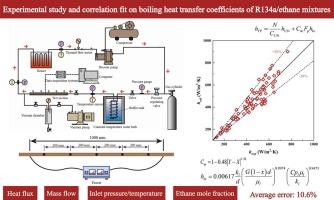R134a/乙烷混合物沸腾换热系数的实验研究与关联拟合
IF 2.6
3区 工程技术
Q2 ENGINEERING, MECHANICAL
International Journal of Heat and Fluid Flow
Pub Date : 2025-08-06
DOI:10.1016/j.ijheatfluidflow.2025.109999
引用次数: 0
摘要
具有温度滑动特性的非共沸混合物可以有效提高有机朗肯循环的换热效率。深入了解其传热特性对于合理设计蒸发器结构和提高系统整体效率至关重要。研究了R134a/乙烷混合物在水平管内的沸腾换热行为。比较了实验结果与数值结果的偏差,并评估了不同操作参数对换热系数的影响。实验条件为热流密度1 ~ 4.7 kW/m2,质量流量28 ~ 37 kg/(m2·s),进口温度235 ~ 248 K,进口压力0.4 ~ 0.75 MPa,蒸汽质量0.06 ~ 0.95。实验结果与已有关联预测结果进行了比较,并提出了新的修正关联。结果表明,传热系数随热通量和质量通量的增加而增加。同时,高质量流量可以加快混合物在管壁上的润湿速率,从而提高其临界蒸汽质量。较高的进口压力增加了汽液密度比,这对传热产生了负面影响。相反,较高的入口温度增强了核沸腾和对流传热。与R134a相比,乙烷摩尔分数具有更好的导热性、更低的蒸汽密度、更低的液体粘度和更低的汽化潜热,从而对换热系数产生积极影响。在实验数据的基础上,提出了一种改进的关系式来预测混合物的换热系数。这种新的相关性预测84.2%的实验数据误差在±20%以内,平均错误率为10.6%。本文章由计算机程序翻译,如有差异,请以英文原文为准。

Experimental study and correlation fit on boiling heat transfer coefficients of R134a/ethane mixtures
Non-azeotropic mixtures, characterized by temperature glide, can effectively enhance the heat transfer efficiency of the Organic Rankine Cycle. A thorough understanding of their heat transfer characteristics is essential for the rational design of evaporator structures and the overall enhancement of system efficiency. This study investigates the boiling heat transfer behavior of R134a/ethane mixtures in a horizontal tube. The deviations of the experimental and numerical results are compared, and the effects of various operating parameters on the heat transfer coefficient are assessed. The experimental conditions include a heat flux range of 1–4.7 kW/m2, mass flow rate of 28–37 kg/(m2·s), inlet temperature of 235–248 K, inlet pressure of 0.4–0.75 MPa, and vapor quality between 0.06 and 0.95. Experimental results are compared with predictions from existing correlations, and new modified correlations are proposed. The results indicate that increasing both heat flux and mass flux leads to a consistent rise in heat transfer coefficients. Meanwhile, high mass flow rate can accelerate the wetting rate of the mixture on the pipe wall, thereby increasing its critical vapor quality. Higher inlet pressures increase the vapor-to-liquid density ratio, which negatively impacts heat transfer. Conversely, higher inlet temperatures enhance nucleate boiling and convective heat transfer. The ethane mole fraction positively impacts heat transfer coefficient owing to its superior thermal conductivity, reduced vapor density, lower liquid viscosity, and decreased latent heat of vaporization compared to R134a. A modified correlation, based on experimental data, is presented for predicting the heat transfer coefficient of mixtures. This new correlation predicts 84.2 % of the experimental data within ±20 % error, with an average error rate of 10.6 %.
求助全文
通过发布文献求助,成功后即可免费获取论文全文。
去求助
来源期刊

International Journal of Heat and Fluid Flow
工程技术-工程:机械
CiteScore
5.00
自引率
7.70%
发文量
131
审稿时长
33 days
期刊介绍:
The International Journal of Heat and Fluid Flow welcomes high-quality original contributions on experimental, computational, and physical aspects of convective heat transfer and fluid dynamics relevant to engineering or the environment, including multiphase and microscale flows.
Papers reporting the application of these disciplines to design and development, with emphasis on new technological fields, are also welcomed. Some of these new fields include microscale electronic and mechanical systems; medical and biological systems; and thermal and flow control in both the internal and external environment.
 求助内容:
求助内容: 应助结果提醒方式:
应助结果提醒方式:


